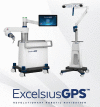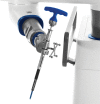The current state of navigation in robotic spine surgery
- PMID: 33553379
- PMCID: PMC7859750
- DOI: 10.21037/atm-2020-ioi-07
The current state of navigation in robotic spine surgery
Abstract
The advent and widespread adoption of pedicle screw instrumentation prompted the need for image guidance in spine surgery to improve accuracy and safety. Although the conventional method, fluoroscopy, is readily available and inexpensive, concerns regarding radiation exposure and the drive to provide better visual guidance spurred the development of computer-assisted navigation. Contemporaneously, a non-navigated robotic guidance platform was also introduced as a competing modality for pedicle screw placement. Although the robot could provide high precision trajectory guidance by restricting four of the six degrees of freedom (DOF), the lack of real-time depth control and high capital acquisition cost diminished its popularity, while computer-assisted navigation platforms became increasingly sophisticated and accepted. The recent integration of real-time 3D navigation with robotic platforms has resulted in a resurgence of interest in robotics in spine surgery with the recent introduction of numerous navigated robotic platforms. The currently available navigated robotic spine surgery platforms include the ROSA Spine Robot (Zimmer Biomet Robotics formerly Medtech SA, Montpellier, France), ExcelsiusGPS® (Globus Medical, Inc., Audubon, PA, USA), Mazor X spine robot (Medtronic Navigation Louisville, CO; Medtronic Spine, Memphis, TN; formerly Mazor Robotics, Caesarea, Israel) and TiRobot (TINAVI Medical Technologies, Beijing, China). Here we provide an overview of these navigated spine robotic platforms, existing applications, and potential future avenues of implementation.
Keywords: Navigation; image guidance; robotics; spine surgery.
2021 Annals of Translational Medicine. All rights reserved.
Conflict of interest statement
Conflicts of Interest: All authors have completed the ICMJE uniform disclosure form (available at http://dx.doi.org/10.21037/atm-2020-ioi-07). The series “Current State of Intraoperative Imaging” was commissioned by the editorial office without any funding or sponsorship. BNS reports personal fees from Medtronic, outside the submitted work and is a member of the Medtronic Robotics Advisory Board. The authors have no other conflicts of interest to declare.
Figures






References
Publication types
LinkOut - more resources
Full Text Sources
Other Literature Sources
